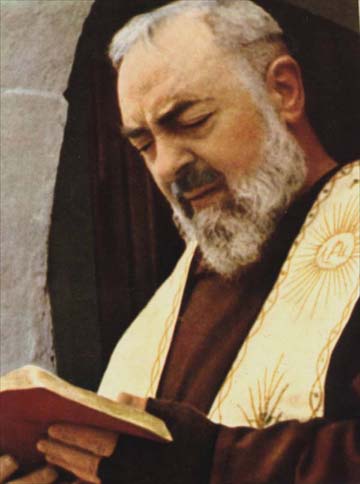One of the most
popular pilgrimage sites in Italy today is San Giovanni Rotondo where,
for 50 years, Padre Pio, now Saint Pio of Pietrelcina, was dedicated to
a ministry of healing, both body and spirit. Consumed by a longing to
care for souls, he spent many hours each day hearing confessions and
praying. He would say, “In books we seek God, in prayer we find him.
Prayer is the key which opens God’s heart.”
Padre Pio was
baptized with the name of Francis, and like the saint of Assisi, he
received the stigmata, bearing in his body the marks of Christ’s
Passion. He had many other mystical experiences throughout his life as
well. “Those who went to San Giovanni Rotondo to attend his Mass, to
seek his counsel or to confess to him, saw in him a living image of
Christ suffering and risen,” affirmed Blessed Pope John Paul II. Given
his reputation for sanctity, people would write to Padre Pio, asking for
prayers, and many miraculous healings have been attributed to his
intercession. He also established a hospital – the Home for the Relief
of Suffering.
By his teaching
Padre Pio invites us to pray, to receive divine mercy through the
sacrament of Penance and to love our neighbor.” He shows us the path to
spiritual purification.
How often we seek
the presence of saints like Padre Pio. We ask them to intercede for us.
We journey to places where they lived and where they now rest. Going
not as mere tourists for entertainment, we travel as pilgrims to
experience the reality of our living faith and grow closer to God.
Pilgrimages to holy
places have been undertaken from the earliest days for a number of
reasons, such as seeking divine assistance, in thanksgiving, as penance
for sin, or for spiritual growth and devotion. As part of the Year of
Faith, special pilgrimage sites have been designated throughout the
Archdiocese of Washington. There the pilgrim is invited to meet the
mystery of God and discover his merciful love. The grace of a plenary
indulgence is also available during this Year.
Even when we’ve
been forgiven, the sins we committed have consequences, including what
is called “temporal punishment.” As Pope John Paul II explains, this
punishment “expresses the condition of suffering of those who, although
reconciled with God, are still marked by those ‘remains’ of sin which do
not leave them totally open to grace” and, among other things, weakens
their ability in this life to resist temptation. So, to help the
faithful, the Church opens the richness of her spiritual treasury by
making available indulgences, which are the full or partial remission of
that temporal punishment. This aids the repentant sinner to generous
and radical conversion – a turning away from sin and toward God. Here
we find ourselves again at the heart of the Paschal Mystery, dying in
order to live.
During the Year of
Faith, a plenary indulgence is possible if in the course of a visit to a
designated pilgrimage site a person who is truly repentant takes part in
some sacred function or at least prays with devout attention, has
received the Sacrament of Penance, assists at Mass and prays for the
intention of Our Holy Father, the Pope. These prayers usually include
the Our Father, a Profession of Faith and invocations to the Blessed
Virgin Mary or the patron saint of the place.
During the
pilgrimage, we remember that we walk with our spiritual family, the
Church, and with all the saints who have already completed the journey.
They help us on our way, so that we, too, may someday enjoy with them
the blessed vision of the glory of God forever.
In this way, no
longer wandering aimlessly in the desert, we advance in our ultimate
pilgrimage toward the promised land of eternal life. We don’t travel
alone. We walk with our spiritual family, the Church, with Padre Pio
and the other saints who’ve already completed the journey. They help us
on our way so that we too may enter into the blessed vision of the glory
of God.
Saint Padre Pio,
pray for us!

